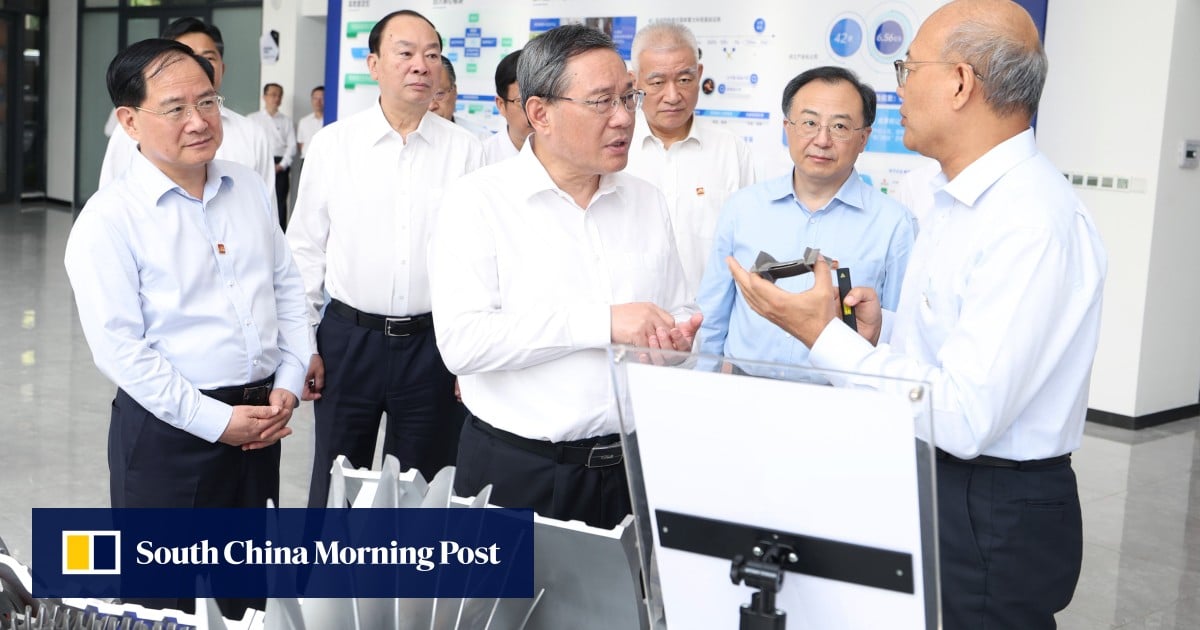
Premier Li Qiang concluded a three-day visit to China’s manufacturing powerhouse province of Guangdong, which is also seen as its frontier of reform and opening up, on Thursday in an attempt to shore up market confidence amid ongoing damaging technology curbs and de-risking efforts from the United States.
Li visited various state-backed laboratories and hi-tech firms in Dongguan and Shenzhen, calling for an increased effort in technology innovation, as well as economic transformation and upgrading, according to the official Xinhua News Agency.
“The policy direction of the tour is quite obvious, that is, the country will engage more in hi-tech and structural transformation,” said Dan Wang, chief economist at Hang Seng Bank China.
“So traditional industries are not the focus of policy attention at all.”
China’s hi-tech industries see ‘abrupt cliff-fall decline’ amid US tech war
China’s hi-tech industries see ‘abrupt cliff-fall decline’ amid US tech war
At Songshan Lake Materials Laboratory in Dongguan on Tuesday, Li said he hoped the facility could promote a deeper integration of industry, university and research, and strive for breakthroughs on key technologies.
At China Spallation Neutron Source, he said it was necessary to strengthen basic research, focus on forging advantages and filling shortcomings, while also helping China to achieve technological self-reliance.
At a symposium with local government and enterprise representatives in Shenzhen, Li said China is at a critical period of economic transformation and upgrading.
Advertisement
He said it was necessary to promote high-quality development and the digitalisation of the manufacturing sector, while also dedicating more effort in shifting the growth model, improving the economic structure and pushing for greater growth momentum.
Whenever there are challenges in economic growth, the central government will go [to Guangdong] for investigation
While Beijing set an annual growth target of “around 5 per cent” earlier this year, many international investment banks have already lowered their growth forecasts for 2023 to below 5 per cent.
“Guangdong is a major economic province and a barometer of China’s economy, so it receives special attention,” said Su Yue, the principal China economist at The Economist Intelligence Unit.
“So whenever there are challenges in economic growth, the central government will go there for investigation.”
Guangdong, as an export-oriented province, is inevitably affected by the global economic slowdown, and the US tech curbs have also been impacting its high-end technology and manufacturing firms, Su added.
Advertisement
“Building a modern industrial system is an important task of Li’s government,” she said.
Su added that more policies on industrial modernisation are expected after Beijing set up its Central Science and Technology Commission in March.
It is necessary to deepen the reform and opening up, and implement more leading reforms in terms of stimulating the vitality of various business entities
Overseen directly by the Communist Party, the committee has taken over the strategic planning and policy setting for China’s science and technology development from the Ministry of Science and Technology.
Advertisement
When visiting various private firms – including Huawei Technologies – in Shenzhen on Wednesday, Li pledged to continue optimising government services and creating a favourable environment for the development of enterprises.
“It is necessary to deepen the reform and opening up, and implement more leading reforms in terms of stimulating the vitality of various business entities, accelerating the construction of a unified national market, and creating a first-class business environment,” Li said during the symposium.
He called for more creative measures to stabilise China’s international market share and attract more foreign capital to further boost economic vitality and growth momentum.
[Li’s tour] at the key infrastructure project also points out the direction for the development of GBA
During the tour, Li also visited a construction site for the Shenzhen-Zhongshan Link, which is expected to fully open next year.
Advertisement
The bridge is a core infrastructure project in the Greater Bay Area – Beijing’s scheme to link nine mainland Chinese cities, including Guangzhou and Shenzhen, as well as Hong Kong and Macau into an integrated economic and business hub
Zhao Xijun, a professor of finance at Renmin University, said the Greater Bay Area is a key strategy in terms of the nation’s regional development, and the transport infrastructure network is the basis for further integration of the area.
“Aside from the policy direction on technology innovation, [Li’s tour] at the key infrastructure project also points out the direction for the development of GBA, that improving the infrastructure is conducive for higher efficiency and better allocation of resources in the area,” Zhao said.
Advertisement


